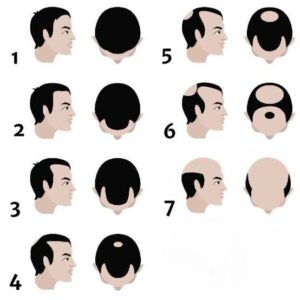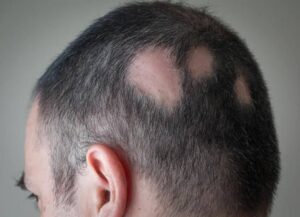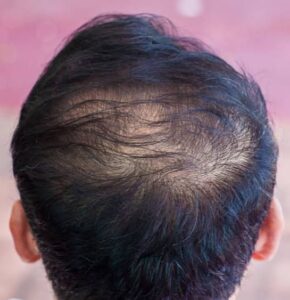You are not alone if you are among the many people who have thinning hair or hair loss. Hair loss is very prevalent in both men and women, but it is more common in men.
Data of 24595 patients diagnosed with hair loss were evaluated. Telogen effluvium (TE) was the commonest reason for hair fall (40.70%), followed by female pattern hair loss (FPHL) (22.09%), alopecia areata (AA) (12.81%), and male pattern hair loss (MPHL) (7.49%) – As per
For many men suffering hair loss, they may want to consider non-surgical treatment options to slow down hair loss and reverse it. Whether you require medical treatment or surgery to restore your hair, Dermatologists at Skinesis Clinique, Vasant Vihar are able to consult you on various solutions to help you with your level of hair loss.
What is Male Hair Loss ?

Millions of men worldwide suffer with male pattern baldness, also referred to as male hair loss. Hairlines gradually thin and recede as a result of hormone fluctuations and heredity. A receding hairline and crown thinning are early indicators. Although the disorder worsens over time, there are therapies that can delay the progression and even cause hair to come back in certain situations. Effective management of the condition can be achieved with prompt intervention under the direction of an expert.
Genetics
Male pattern baldness, also known as androgenetic alopecia, is a condition in which male hair loss is largely inherited. Hormones and genetic predisposition play a role in this inherited illness. As early as their late teens or early twenties, men may begin to lose hair, which frequently results in thinning at the top of the head and a receding hairline.
Hormonal Changes
A significant contributing cause to male hair loss is hormonal alterations, including those involving dihydrotestosterone (DHT). A testosterone derivative called DHT has the ability to shrink hair follicles, which can result in shorter hair growth cycles and eventually hair loss. Hormone fluctuations, which are frequently brought on by aging, can make this disease worse and result in bald or noticeably thinner areas.
Medical Conditions
Male hair loss may result from specific medical issues. Normal hair development can be disrupted by conditions including scalp infections and autoimmune illnesses like alopecia areata. Bald or thinning patches may result from the inactivity of hair follicles brought on by these medical conditions. To lessen hair loss, underlying medical issues should be treated.
Reasons for hair loss typically include:
- Family history: The most prevalent reason of hair loss is hereditary. It indicates that a person’s hair follicles diminish and finally stop growing due to inherited DNA.
- Age: As people age, their hair naturally thins. Thinning hair on the scalp is the result of hair follicles ceasing to produce hair altogether and slowing down hair growth with time.
- Medical issues: Alopecia areata, scarring alopecia, trichotillomania, a chronic hair-pulling disorder, and an underactive or overactive thyroid are among the medical illnesses that can cause hair loss.
- Conditions affecting the scalp: Hair loss may result from psoriasis or an infection like ringworm.
- Medications: Side effects of some medications prescribed by doctors for gout, depression, high blood pressure, arthritis, and heart problems can result in hair loss.
- Treatment for cancer: Within weeks of beginning a course of treatment, hair loss may result from chemotherapy or radiation, especially to the head and neck regions.
- Stress: People may have temporary hair thinning when they are under a lot of stress.
- STIs, or sexually transmitted infections: STIs like syphilis can result in areas of hair loss on the scalp, eyebrows, and face hair if left untreated.
- Nutritional deficiencies: Not getting enough iron, zinc, or biotin can lead to visible hair loss.
Thinning hair occurs naturally as people age, and it tends to be more common in men than women. However, if a person is losing significantly more hair daily, they may have a medical condition that needs assessing by their Doctor
Types of male hair loss include:
- Male pattern baldness
- Alopecia areata
- Telogen effluvium
- Traction alopecia
- Male Pattern Hair Loss
Androgenetic alopecia, another name for male pattern hair loss, can begin at any point after puberty, typically between the ages of 20 and 25. Usually, this kind of hair loss runs in families.
Male pattern hair loss may result from a mix of hormonal and hereditary reasons. Hair typically grows for two to six years, rests for a few months, and then falls out. When a follicle begins to produce new hair, this cycle then begins anew.
Skin cells of the scalp convert testosterone into dihydrotestosterone (DHT). Testosterone and DHT belong to a group of hormones called androgens, contributing to growth and reproduction in both men and women.
There may be variations in a gene that provides instructions for producing proteins known as androgen receptors in people with male pattern hair loss. The gene variation results in increased activity of the androgen receptors in hair follicles, which causes:
- hair follicles to gradually become smaller
- each new hair to grow thinner than the previous hair
- the new hair to grow for less time before falling out
- Alopecia Areta

Alopecia areata is an autoimmune condition where the body’s immune system mistakenly attacks itself.
- Telogen Effluvium

A disorder called telogen effluvium causes more hair to lose out than usual. A person with telogen effluvium may lose up to 300 hairs per day, when most people only lose 100. This is because there is reduced hair volume as a result of more hair follicles than usual going into the resting condition.
Telogen effluvium manifests as a widespread thinning of hair rather than bald patches.
In India, clinicians are unable to identify the true cause of telogen effluvium in about 30% of cases; typical causes include:
- Iron deficiency
- Dietary changes
- Weight loss
- Hypothyroidism or hyperthyroidism
- Certain medications
- Fever
- Infection
- Stress
- Hormonal changes
- Injury
- Surgery
Hair thickness usually returns to normal within a few months once a person resolves the cause.
- Traction Alopecia
Traction alopecia occurs from the continuous strain of the hair follicles, often from tight hairstyles, dreadlocks or braiding. The tension on the hair follicles pulls out hairs, damages the hair follicles and prevents new hairs from growing.
Traction alopecia can be permanent, and preventing strain on the hair follicles by not styling the hair tightly usually allows the hair to regrow.
Non-Surgical Treatment options for Hair Loss
Minoxidil – is a hair loss treatment available as a foam or liquid solution that men can use on their hair and scalp twice a day.
Minoxidil may help slow the rate of hair loss and promote hair regrowth by:
- Reversing follicle miniaturisation
- Stimulating hair follicles from the resting to the hair growth state
- Extending the growth phase of the follicle
Finasteride – Finasteride works by blocking the enzyme 5α-reductase, which converts testosterone to DHT. By decreasing DHT levels in the scalp, Finasteride reduces the effect of DHT on the hair follicles, which reverses hair thinning and helps to stabilise any further hair loss.
If you are currently taking Minoxidil and/ or Finasteride and have successfully stabilised your hair loss you may want to restore hair in areas you have lost it with a hair transplant procedure.
Patients who are actively losing hair at a rate that is not controlled are unfortunately not candidates for hair transplant surgery and should consider taking one or both of the above medications before making plans for surgery. The reason for this is that hair transplant surgery recreates hair in a new area that is potentially permanent. If the underlying process driving hair loss in the rest of the scalp is not controlled, patients may be left with their transplanted hair and no hair elsewhere on the scalp.
- Platelet-rich Plasma (PRP) for Hair Loss
Platelet-rich plasma consists of two elements: plasma, or the liquid portion of blood, and platelets, a type of blood cell that plays an important role in healing throughout the body. Platelets are well-known for their clotting abilities, but they also contain growth factors that can trigger cell reproduction and stimulate tissue regeneration or healing in the treated area. Platelet-rich plasma is simply blood that contains more platelets than normal.
To create platelet-rich plasma, clinicians take a blood sample from the patient and place it into a device called a centrifuge that rapidly spins the sample, separating out the other components of the blood from the platelets and concentrating them within the plasma.
- GFC Hair Treatment (Growth Factor concentrate)
GFC hair treatment is a highly safe and dedicated treatment that involves generating growth factors from your blood for the best results in treating your hair loss.
During the procedure, medical professionals apply growth factors directly to the hair roots by superficially injecting them into the scalp.
The GFC treatment not only helps prevent hair loss but also stimulates hair growth, enhances the thickness of hair follicles, and boosts the overall number of hairs.
- GFC can produce outcomes in fewer sessions over PRP.
- Exosomes Treatment
Exosomes are the small messenger cells secreted by stem cells or other sources. They carry bioactive molecules like growth factors, cytokines, and microRNAs, which stimulate hair growth and regulate hair follicle functions.
By injecting these concentrated exosomes into the scalp, they can prolong the hair growth phase for thicker strands, reverse follicle shrinkage for healthier hair, and activate dormant hair follicles to generate new hair. Autologous Exosome hair therapy is a less invasive and potentially more powerful option than PRP for individuals seeking treatment for hair loss and thinning hair.
Unlike PRP, exosome therapy uses pre-packaged exosomes derived from stem cells that contain a higher concentration of hair growth factors, proteins, and other regenerative materials. Exosomes are more potent and have shown quicker, more consistent results in hair restoration compared to PRP.
Note: Consult the Dermatologist at Skinesis Clinique, Vasant Vihar, New Delhi for hair loss, thinning, or baldness related issues – We recommend that the above details are for informational purposes not for the self treatment, Always consult the Skin doctor before going for any treatments.
